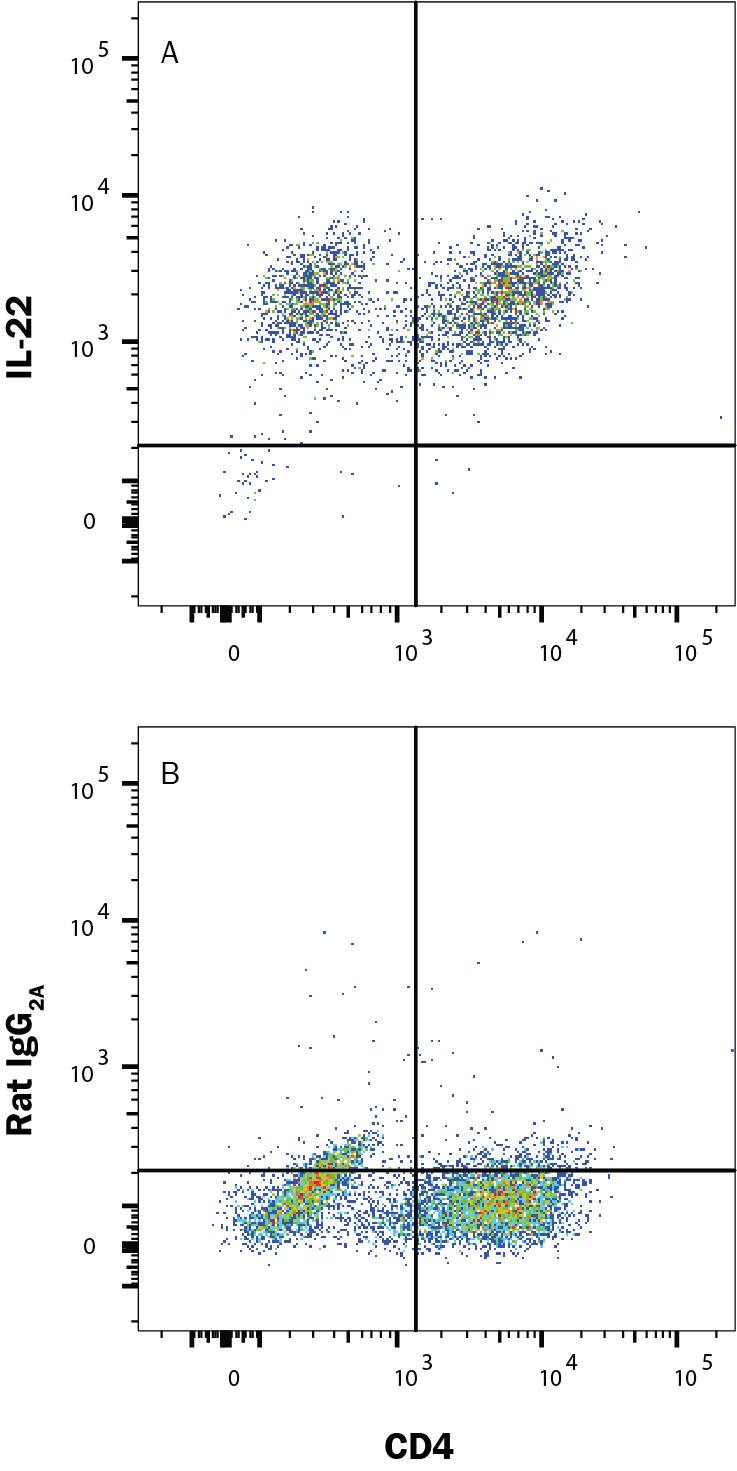Mouse IL-22 PE-conjugated Antibody
R&D Systems, part of Bio-Techne | Catalog # IC582P


Key Product Details
Species Reactivity
Validated:
Cited:
Applications
Validated:
Cited:
Label
Antibody Source
Product Specifications
Immunogen
Leu34-Val179
Accession # Q9JJY9
Specificity
Clonality
Host
Isotype
Scientific Data Images for Mouse IL-22 PE-conjugated Antibody
Detection of IL‑22 in Mouse Th17 Splenocytes by Flow Cytometry.
Mouse splenocytes differentiated to Th17 cells with plate-bound Rat anti-Mouse CD3e monoclonal antibody (MAB484, 5 µg/mL) plus Goat anti-Mouse CD28 (AF483, 5 µg/mL), Recombinant Human TGF-beta 1 (240-B, 10 ng/mL) Recombinant Mouse IL-23 (1887-ML, 20 ng/mL), Recombinant Mouse IL-6 (406-ML, 40 ng/mL), Recombinant Mouse IL-1 beta (401-ML, 10 ng/mL), and Rat anti-Mouse IFN-gamma (MAB485, 10 µg/mL) for 5 days were stained with APC-conjugated Rat anti-Mouse CD4 Monoclonal Antibody (Catalog # FAB554A) and (A) Rat Anti-Mouse IL-22 Fluorescein-conjugated Monoclonal Antibody (Catalog # IC582F) and (A) Rat Anti-Mouse IL-22 PE-conjugated Monoclonal Antibody (IC582P) or (B) isotype control antibody (IC006P). To facilitate intracellular staining, cells were fixed and permeabilized with FlowX FoxP3/Transcription Factor Fixation & Perm Buffer Kit. (FC012). View our protocol for Staining Intracellular Molecules.Detection of IL-22 in EL4 cells by Flow Cytometry.
EL4 cells were stained with Rat Anti-Mouse IL-22 PE-conjugated Monoclonal Antibody (Catalog # IC582P, filled histogram) or isotype control antibody (Catalog # IC006P, open histogram). To facilitate intracellular staining, cells were fixed and permeabilized with FlowX FoxP3 Fixation & Permeabilization Buffer Kit (Catalog # FC012). View our protocol for Staining Intracellular Molecules.Applications for Mouse IL-22 PE-conjugated Antibody
Intracellular Staining by Flow Cytometry
Sample: Mouse splenocytes treated with plate-bound Rat anti-Mouse CD3 epsilon monoclonal antibody (Catalog # MAB484, 5 μg/ml) plus Goat anti-Mouse CD28 (Catalog # AF483, 5 μg/ml), Recombinant Human TGF-beta 1 (Catalog # 240-B, 10 ng/ml) Recombinant Mouse IL-23 (Catalog # 1887-ML, 20 ng/ml), Recombinant Mouse IL-6 (Catalog # 406-ML, 40 ng/ml), Recombinant Mouse IL-1 beta (Catalog # 401-ML, 10 ng/ml), and Rat anti-Mouse IFN-gamma (Catalog # MAB485, 10 μg/ml) for 5 days were fixed and permeabilized with FlowX FoxP3/Transcription Factor Fixation & Perm Buffer Kit. (Catalog # FC012) and EL‑4 mouse lymphoblast cell line.
Formulation, Preparation, and Storage
Purification
Formulation
Shipping
Stability & Storage
- 12 months from date of receipt, 2 to 8 °C as supplied.
Background: IL-22
Interleukin-22 (IL-22), also known as IL-10-related T cell-derived inducible factor (IL-TIF) was initially identified as a gene induced by IL-9 in mouse T cells and mast cells. Mouse IL-22 cDNA encodes a 179 amino acid (aa) residue protein with a putative 33 aa signal peptide that is cleaved to generate a 146 aa mature protein that shares approximately 79% and 22% aa sequence identity with human IL-22 and IL-10, respectively. The mouse IL-22 gene is localized to chromosome 10. Although it exists as a single copy gene in many mouse strains, the IL-22 gene is duplicated in some mouse strains including C57B1/6, FVB and 129. The two mouse genes designated IL-TIF alpha and IL-TIF beta, share greater than 98% sequence homology in their coding region. IL-22 has been shown to activate STAT-1 and STAT-3 in several hepatoma cell lines and upregulate the production of acute phase proteins. IL-22 is produced by normal mouse T cells upon Con A activation. Mouse IL-22 expression is also induced in various organs upon lipopolysaccharide injection, suggesting that IL-22 may be involved in inflammatory responses. The functional IL-22 receptor complex consists of two receptor subunits, IL-22R (previously an orphan receptor named CRF2-9) and IL-10R beta (previously known as CRF2-4), belonging to the class II cytokine receptor family.
References
- Dumoutier, L. et al. (2000) J. Immunol. 164:1814.
- Xie, M-H. et al. (2000) J. Biol. Chem. 275:31335.
- Dumoutier, L. et al. (2000) PNAS 97:10144.
- Kotenko, S.V. et al. (2001) J. Biol. Chem. 276:2725.
Long Name
Alternate Names
Gene Symbol
UniProt
Additional IL-22 Products
Product Documents for Mouse IL-22 PE-conjugated Antibody
Product Specific Notices for Mouse IL-22 PE-conjugated Antibody
For research use only
